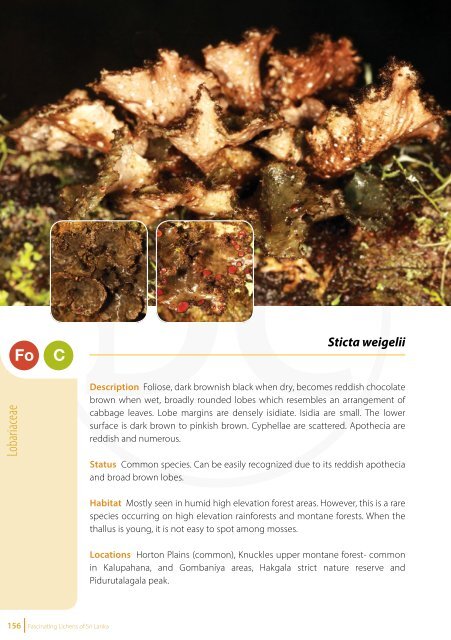Create successful ePaper yourself
Turn your PDF publications into a flip-book with our unique Google optimized e-Paper software.
Usnea<br />
Beard lichens, Old man’s beard<br />
Lecanorales Usneaceae<br />
c.500<br />
Usnea is a cosmopolitan genus found in cool, wet, temperate areas and montane<br />
rainforests in tropical and sub tropical areas. Species <strong>of</strong> Usnea are collectively<br />
referred as old man’s beard. This is a very large genus <strong>of</strong> conspicuous fruticose<br />
lichens comprising more than 500-600 species. It is found on rocks, bark, wood,<br />
canopy branches, twigs, shrubs, and soil in a very wide range <strong>of</strong> habitats. Also<br />
it is noteworthy that some species have been observed on sign boards, power<br />
poles, fence posts and grave tombs etc. invading man-made structures in moist,<br />
humid high elevation areas.<br />
This genus is under revision at the moment due to the molecular data change<br />
causing the delimitation <strong>of</strong> species within the genus. Many species which were<br />
known under one common name have been identified as consisting distinct<br />
lineages. In <strong>Sri</strong> <strong>Lanka</strong>, the genus remains very poorly known.<br />
Lobariaceae<br />
Fo<br />
C<br />
Sticta weigelii<br />
Description Foliose, dark brownish black when dry, becomes reddish chocolate<br />
brown when wet, broadly rounded lobes which resembles an arrangement <strong>of</strong><br />
cabbage leaves. Lobe margins are densely isidiate. Isidia are small. The lower<br />
surface is dark brown to pinkish brown. Cyphellae are scattered. Apothecia are<br />
reddish and numerous.<br />
Status Common species. Can be easily recognized due to its reddish apothecia<br />
and broad brown lobes.<br />
In montane forests <strong>of</strong> the central highlands, Usnea is a dominant component<br />
<strong>of</strong> the forest canopy, which is one <strong>of</strong> the least studied habitats in <strong>Sri</strong> <strong>Lanka</strong>.<br />
Recent work carried out by Weerakoon and Aptroot (2014) recorded six new<br />
Usnea species for <strong>Sri</strong> <strong>Lanka</strong> including four species that are new records for the<br />
Indian subcontinent. Around 15-20 species are known from <strong>Sri</strong> <strong>Lanka</strong>, that need<br />
taxonomic revision using molecular and chemical data.<br />
Usnea can be easily distinguished from similar genera by having a characteristic<br />
central cord. Usnea is one <strong>of</strong> the most commercially important lichens because<br />
<strong>of</strong> its use in the production <strong>of</strong> usnic acid, an effective antibiotic against certain<br />
bacteria. Some species <strong>of</strong> Usnea are used in dye-making and are also used to<br />
brew beer (in Mexico). Usnea species are also important to wildlife as both food<br />
and nesting material.<br />
Usneaceae<br />
Habitat Mostly seen in humid high elevation forest areas. However, this is a rare<br />
species occurring on high elevation rainforests and montane forests. When the<br />
thallus is young, it is not easy to spot among mosses.<br />
Locations Horton Plains (common), Knuckles upper montane forest- common<br />
in Kalupahana, and Gombaniya areas, Hakgala strict nature reserve and<br />
Pidurutalagala peak.<br />
Apothecia lecanorine, lateral, subterminal or terminal, disc pruinose, concave<br />
to plane, usually pale lemon green; Asci: 8-spored; Spores: colourless, simple<br />
ellipsoid.<br />
Chemistry Usnic acid present in cortex <strong>of</strong> all species KC+ dark yellow, medulla<br />
with a varied chemistry. Many different chemotypes are present even within<br />
the same species, therefore TLC is essential for the correct identification <strong>of</strong> the<br />
species.<br />
156 <strong>Fascinating</strong> <strong>Lichens</strong> <strong>of</strong> <strong>Sri</strong> <strong>Lanka</strong><br />
<strong>Fascinating</strong> <strong>Lichens</strong> <strong>of</strong> <strong>Sri</strong> <strong>Lanka</strong> 157















